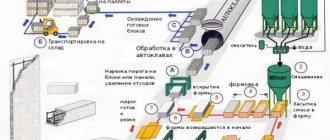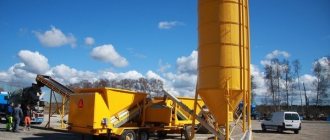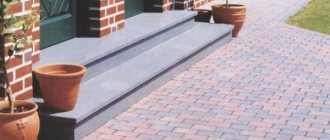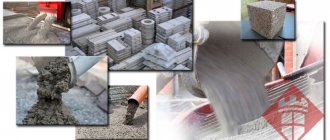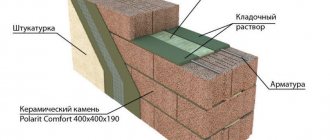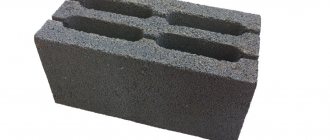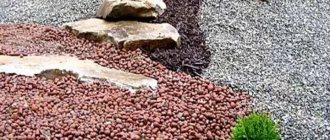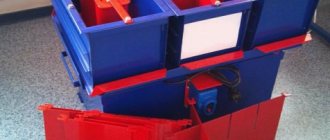Composition and characteristics
Expanded clay contains clay and its shale; the manufacturing process takes place by firing the initial raw material mass in special furnaces
At a temperature of 1,000 - 1,300 degrees, the clay swells and goes into a pyroplastic state. Taking into account the quality of the source material, the created temperature regime, the duration of the firing process and other technological features of manufacturing, different technical indicators of the material are obtained, the most significant of which are grain sizes, density and volumetric weight.
The parameters of expanded clay are determined by GOST, which regulates the quality indicators of building materials with a porous structure. Some indicators are not regulated, but they still remain important characteristics. Let's look at the main properties in more detail:
- expanded clay fractions. There are only three of them, and the sizes vary in the ranges of 5 - 10, 10 - 20, 20 - 40 mm. Fractions used in construction are included in a separate category. These are granules and crushed stone, the sizes of which range from 2.5 to 10 mm, and wide mixed fractions from 5 to 20 mm;
- grades by bulk density. There are seven of them in total. This parameter determines the density of the material without taking into account the intermediate areas formed by granules or fragments;
- strength indicator. There are thirteen grades of gravel material; there are slightly fewer grades for crushed stone - only eleven. The strength indicator of crushed stone and gravel of the same brand is different. There is a relationship between expanded clay grades in terms of density and strength values - an increase in density entails an increase in strength;
- compaction coefficient. This value is agreed with the consumer and does not exceed 1.15. It is used to take into account the compaction of expanded clay during transportation and storage. This indicator is often used when loading material and selling it;
- thermal conductivity. One of the important indicators that determines the thermal insulation capabilities of expanded clay. The range is narrow, which confirms the high thermal insulation properties of expanded clay, and this coefficient increases with increasing density;
- moisture absorption. This important parameter shows changes in the qualities of expanded clay under the influence of water. Expanded clay is considered a relatively stable material, the moisture absorption value is 8 - 20 percent;
- sound insulation. The best performance with expanded clay can be achieved by pouring expanded clay under a wooden floor;
- frost resistance. Due to low moisture absorption and the characteristics of the main raw material (clay), expanded clay has high frost-resistant properties.
Expanded clay structure
Expanded clay is a natural material in the form of round granules with pores. It is produced by melting and firing clay. This material has many advantages and a fairly wide range of applications.
Expanded clay, the structure of which is not susceptible to hot or cold water, as well as any temperature changes, has found its application in the fields of construction, gardening and even landscape design. It is absolutely safe, environmentally friendly, has high heat and noise insulation properties, fire and frost resistance, durability and strength. Moreover, since expanded clay is made from clay, it is not susceptible to the formation of fungus, mold and does not rot.
Varieties of expanded clay
1. Expanded clay sand is a lightweight filler for mortars and concrete, with a particle size of 0.14-5 mm. Also used for thermal insulation backfill with insulation thickness no more than 50 mm.
2. Expanded clay gravel - used for filling lightweight concrete and as insulation for roofs, floors and walls. Fraction size 5-40 mm.
3. Expanded clay crushed stone is a very light filler for concrete, usually angular in appearance, with a grain size of 5-40 mm. Crushed stone is produced by crushing large pieces of expanded clay mass.
Expanded clay: material structure
The basic raw materials for the production of expanded clay material are clayey rocks, usually sedimentary rocks. Clay rocks have a complex mineralogical composition and include quartz, feldspars, carbonates, organic and ferruginous impurities.
To produce expanded clay, hydromica and montmorillonite clays containing <30% quartz, <70% SiO2, >12% Al2O3 (preferably closer to 120%), <10% Fe2O3 + FeO and 1-2% organic impurities are used.
The suitability of raw materials for expanded clay production is determined by its examination, the main requirement for which is its swelling during firing (determined by the swelling coefficient).
Another requirement for clay is its fusibility. The temperature during firing should not exceed 1250°C, at which the necessary softening and viscosity of the clay mass should be ensured. Otherwise, the gases formed during the firing process may escape without swelling the material.
Another important requirement is the clay swelling interval - the difference between the maximum firing temperature and the temperature at which the raw material swells. The temperature at the moment of swelling is considered to be the temperature at which expanded clay is produced, the structure of which has a density of 0.95 g/cm3, and the maximum firing temperature is the melting point of the granules.
You might be interested:
- Expanded clay 0-5 mm in 50 l bags
- Expanded clay gravel
- Expanded clay 10-20 mm
- Expanded clay in bags 10-20 mm
Features of manufacturing technology
With the help of special studies of the feedstock, its suitability for the production of expanded clay is determined. The main requirements for the initial material are:
- possibility of swelling from firing;
- easy fusibility;
- a certain time for swelling.
Special components are sometimes added to the raw material to improve swelling.
This can be fuel oil or diesel oil, perlite, anulite, etc. The result of processing raw materials is raw granules with a certain size and composition. They are first dried, then fired and cooled. At the next stage of production, the material is sorted by density and, if necessary, crushed to produce smaller fractions. At the end of everything, the expanded clay is sorted, stored or shipped for shipment.
The whole process in its essence is as follows: after preparation, the clay is subjected to thermal shock, which gives it porosity and promotes the swelling process. Due to the melting of the shell, expanded clay receives sealing and becomes durable.
Raw materials for the production of expanded clay
A budding entrepreneur should know: what is expanded clay made of? The material is made from clay with a small quartz content (less than 30%). These are mainly sedimentary clayey rocks. Metamorphic raw materials (stone-like) are used much less frequently. Using special studies, they check how well the raw materials meet the established requirements.
Clay for the production of expanded clay must be fusible and swell under the influence of high temperatures with a certain frequency. Special additives, which are sometimes introduced into raw materials during the production process, increase the swelling coefficient. Organic (fuel oil, diesel fuel) or ferrous substances are mainly used.
Extraction of feedstock
The production process begins with the extraction of raw material by quarrying and its transportation to clay reserves. Development is carried out in an open way, using single- and multi-bucket excavators. Individual layers are not identified; production occurs throughout the entire height.
When extracting stone-like rocks in the form of mudstone and clay shales, drilling and blasting operations are used. Such breeds can be developed at any time of the year, while soft breeds can only be developed during the appropriate period.
To ensure that the production process continues uninterruptedly, special frost-resistant clay storage facilities are built to hold a six-month supply of raw materials. You can use intermediate cones for storage, in which the clay is kept in the open air for several months.
Production of expanded clay
Under the influence of temperature, periodic wetting and drying, the structural structure of the raw material is partially disrupted, which significantly facilitates the process of its subsequent processing into a homogeneous mass.
Expanded clay manufacturing process
The properties of the material are influenced by how expanded clay is made. After all, it is during the manufacturing process that the material acquires its unique properties. It should be noted that the word “expanded clay” is translated from Greek as “burnt clay.” The technology for producing expanded clay is that the prepared clay is subjected to powerful thermal shocks. As a result, the material swells and acquires the desired porosity. Under the influence of high temperatures, the outer shell of the granules melts, thanks to this, the expanded clay is sealed and acquires high strength characteristics.
Technological diagram for the production of expanded clay
The technological scheme for the production of expanded clay is as follows:
- extraction of raw materials and their delivery to a storage point;
- processing of incoming raw materials and preparation of granules or grains of a certain size;
- heat treatment of raw materials: drying, roasting, cooling;
- sorting, crushing (if necessary), separation of finished products depending on density;
- warehousing, or shipping and delivery to the customer.
Clay deposits are developed using the open-pit method. Raw materials are extracted using excavators (single-bucket or multi-bucket). Extraction of metamorphic clay (shale, mudstone) involves preliminary drilling and blasting.
Clay storage facilities ensure continuity of expanded clay production by storing a six-month supply of raw materials and keeping them from freezing. Clay is also stored outdoors in special intermediate cones. At the same time, natural changes in temperature (especially frost) and humidity contribute to the destruction of the natural structure of clay, which facilitates its subsequent processing.
Methods for producing expanded clay granules
To make expanded clay, one of four methods is used
Dry method
It is used if expanded clay is obtained from dense rocky clayey rocks and shale, a different manufacturing technology is used. The source material is crushed using crushing equipment to obtain grains measuring 1–20 mm. Expanded clay raw materials are fired in a drum kiln, cooled, and distributed into fractions. In this production option, the grain molding step is not provided, and the final product has a cubic angular shape.
Wet method
The clay is placed in large containers called clay mixers. After this, water is poured in to create a slip with a humidity level of up to fifty percent. Pumping units pump it into slurry basins, from where it enters rotary kilns. In the kiln drums, the granules are broken down into individual granules, which are dried by the gases released by the kiln.
The method involves high fuel consumption, since the moisture level of the slip is quite high. But with its help, the raw material is cleared of rocky inclusions, additives are introduced into it to obtain a homogeneous mass. This option is used for raw materials with a high moisture content.
Plastic method
Prepared natural clay, the moisture content of which does not exceed thirty percent, is subjected to two stages of grinding on special gear rollers - coarse and fine. From this process, granules are formed, the diameter of which is 5 - 10 mm, which enter the drying drums. In them, the semi-finished product is dried and subjected to final rolling until it acquires an oval shape. After this, firing begins, for which a temperature regime is created in the furnaces from 800 to 1,350 degrees. The process takes place under constant rotation of the furnace drums. Sintered ceramic granules, which have increased in diameter due to swelling, end up in rotating refrigeration units. After cooling, the final stage begins - the expanded clay is dispersed into fractions.
Powder-plastic method
How is expanded clay produced in this way? The starting material in a dry state is brought to a powdery mass, then water is added to it. As a result, a plastic mass is formed, suitable for the formation of granules. The method is considered quite expensive because the raw materials have to be additionally crushed. The second drawback is that the granules are subject to additional drying.
Since the quality of expanded clay depends on the quality of the raw material, the clay should be well processed and granules of the same size should be formed from it, the parameters of which will increase when expanded.
Application of expanded clay in construction
Expanded clay is a universal material. It is widely used not only in the construction of buildings, but also in the construction of infrastructure: roads and highways, in agriculture, and gardening.
Let's consider the benefits of expanded clay for construction:
- Highly efficient insulation. The porosity of the material makes it a good insulator, therefore expanded clay is used to insulate the walls of a house from the outside by filling the space between the main, load-bearing wall and the facing layer of brick or other material. In the same way, the ceiling is insulated by laying a layer on the attic floor and the floor, creating a crimson layer between the cement screed and the subfloor. Also used as an insulating fill under wooden flooring. Expanded clay can be used to insulate walls, floors and roofs
- Production of expanded clay concrete building blocks. Expanded clay is the main material for the production of such a unique, highly efficient and environmentally friendly material for building houses as expanded clay concrete blocks. Read more about the properties of expanded clay concrete. production of expanded clay blocks
- Good substrate for many substrates. It is used as a substrate for a system - warm floor, for pouring insulated floor screed; the use of expanded clay eliminates the need to lay a deep foundation that will not freeze.
- Insulation for heating systems. Due to its low thermal conductivity, expanded clay mound maintains a stable temperature in plumbing systems and contributes to a systematic decrease or increase in temperature in them, with a sharp change in temperature.
- Used to level floors. Thanks to the light weight of expanded clay, it is possible to level out large differences in the plane of the flooring without creating additional weight load on the foundation. 5-10 cm of crushed stone or clean concrete screed is much heavier than the same layer of expanded clay.
Equipment for the production of expanded clay
We found out what expanded clay is made from. It remains to figure out how the production line for the production of this building material is structured. It includes the following units and accessories:
- loosening devices;
- perforated rollers;
- clay mixers;
- drying drums;
- kilns in which firing is carried out;
- bunkers;
- pneumatic conveyors, belt and other conveyors;
- trays;
- gravel sorters.
Expanded clay production requires a clay mixer. A
special crushing plant is used for the primary processing of the source material. It consists of a grinding unit, which includes:
- blade-type shafts capable of performing rotational movements towards each other;
- rigid frame;
- gear drive;
- receiving bunker.
As soon as the shafts begin to rotate, the raw materials are crushed to the required size. Special additives are introduced through a mixing plant.
The raw materials are fired in furnaces with rotating drums having cylindrical bodies made of steel material. Structurally, the furnace consists of the following elements:
- heads for loading raw materials and unloading material;
- reference station;
- drives;
- end seals;
- crown pair casing, etc.
The furnace is installed on the foundation platform. The support is a welded frame and rollers that regulate its position.
What raw materials are purchased for the production of expanded clay?
Any aspiring businessman needs to know what material he will have to work with.
The main requirement that is put forward when choosing raw materials for the production of expanded clay:
- The main component is clay, which contains less than 30% quartz. As a rule, this is clay from sedimentary rocks. It should swell easily, i.e. draw air under the influence of high temperatures. Another important property that clay should have is fusibility.
- Sometimes stone-like raw materials are used. But then you will have to conduct research to see whether such a rock is suitable as a base for expanded clay, and whether the equipment can process such material.
- Diesel fuel is added to increase the swelling of the granules.
The main raw material is clay, and the equipment itself will do the rest of the work.
Expanded clay production technology
Expanded clay is baked clay. This is exactly what the literal translation of this word from Greek sounds like.
By and large, these two words describe the entire process of expanded clay production. Clay, under the influence of strong thermal shocks, swells and becomes porous, i.e. turns into expanded clay. At the exit, the resulting granules once again fall under a powerful heat flow, due to which the expanded clay shell becomes hard and durable.
Expanded clay production technology in stages:
- Clay is delivered to production. The technologist checks its properties, because not every variety will ultimately be able to provide high-quality expanded clay.
- The material is processed (crushed and sifted), excess impurities are removed and prepared for the next stage.
- The raw material is dried, fired and cooled.
- If some granules have come together, they need to be sorted and separated.
- Expanded clay is sorted into bags of different sizes or simply taken to a warehouse.
The production of expanded clay is especially beneficial for those who have their own clay quarry. Indeed, in this case, the entrepreneur will not have to purchase material; he can make a profit not only from the sale of the clay itself, but also from the production of building materials - expanded clay.
There is one technology for the production of expanded clay for everyone. Unless it will vary slightly depending on the selected equipment.
But the methods for making the granules themselves differ from each other:
| Dry method | It is used if you purchase stone clay, which will be crushed before entering the oven. |
| Wet method | The clay is diluted with water, then granules are formed, dried and fired. |
| Plastic | The required amount of water is added to the clay, the raw materials are placed in a press, then granules are formed using a special machine and fired. |
| Powder-plastic | Clay is turned into powder, i.e. They are crushed very finely, granules are formed from the resulting raw materials, which are processed at high temperatures. |
Equipment for the production of expanded clay
Equipment for the production of expanded clay is the most important stage in creating a business.
Today you can buy any equipment, from any manufacturer. The choice is limited only by the amount of capital available.
A good average choice would be a complete line that is capable of producing up to 100 thousand cubic meters of expanded clay per year. Such equipment will occupy approximately 500 m2, and about 15 workers should work around it.
The set of equipment for the production of expanded clay includes:
| № | Application area of the machines |
| 1. | A machine that loosens clay. Equipped with power supply and grilles. |
| 2. | Mixer. |
| 3. | Hole rollers that will release stones, i.e. sift out rejects and slag from clay. |
| 4. | Dryer. |
| 5. | The oven must be rotating, have a loading and unloading machine, a support station, a compactor, etc. The stove is placed on a separate support, which must have a welded frame, rollers, and the foundation must be made of stone or durable concrete. |
| 6. | Apparatus for sorting finished expanded clay. |
| 7. | Crusher for breaking expanded clay after production. |
| 8. | Bunker for storing clay and finished material. |
| 9. | Machine for transporting and supplying raw materials/finished expanded clay. |
| 10. | Trays for forming granules. |
| 11. | Conveyor. |
| 12. | Silo can. |
The price of such equipment depends on the country of manufacture, the power of the device, the year of manufacture, etc. The approximate cost is from 8 million rubles.
If you don’t have that amount, then you should think about buying a used line or machines separately. If your business idea takes off and things go well, you can save up money for an automated line.
What machines do you need to purchase to create your own complete line for the production of expanded clay:
| 1 | Crusher with roller mechanism for gravel. |
| 2 | Chopper. |
| 3 | Ball mill. |
| 4 | Conveyor. |
| 5 | Mixer for raw materials. |
| 6 | Bunker. |
Such a mini-factory can be assembled for about 1 million rubles.
We would like to draw your attention to the fact that when purchasing a whole line, you will be given a 1-year warranty, i.e. If the equipment breaks down, they will send you a repairman at the manufacturer’s expense. Then you will have to hire a specialist at your own expense. They will also charge you money for installing equipment and training for plant workers.
When purchasing used equipment or assembling a line manually, no one will provide you with a guarantee. It’s better to still find money, or, as a last resort, take out a loan and purchase, perhaps not such a powerful line for the production of expanded clay, but a new one and with a full package of documents.
We hire employees and rent a workshop for a mini-factory
To organize the operation of the plant, the entrepreneur will have to rent premises or buy a production workshop. Of course, buying is more expensive, but you won’t end up overpaying for rent. In the future, the workshop can be resold or also rented out.
Since novice businessmen still prefer to rent production workshops, we will consider this option in our business plan.
To produce expanded clay, an area of 500 square meters is required. In the countryside. Ceiling height is 5-8 meters, depending on the dimensions of the equipment. The approximate price is from 250,000 rubles per month of rent.
What should be in the production workshop:
- Directly the workshop itself, where the production process will take place.
- Bunker for storing raw materials, i.e. clay.
- Bunker for storing expanded clay.
- An office for personnel (director, technologist and accountant), as well as a rest room for workers.
- We also need to build a shower so that people can wash themselves after their shift.
- Bathroom and closet for storing various household equipment.
The workshop and bunkers do not have to be renovated, but cleanliness and order in them are still desirable. But you need to spend money on an office for administrative staff and workers. Buy computers, furniture, showers, build a kitchenette with a kettle, microwave and refrigerator. You need to spend at least 100,000 rubles.
You don’t have to buy everything from the store; you can buy a lot secondhand and thereby reduce your expenses.
The equipment is energy-intensive, so a lot of money will be spent on utility bills. It is difficult to calculate the exact amount - it will vary for each production. You need to focus on a total amount of 150 thousand rubles for housing and communal services.
Among the personnel, one cannot do without a technologist in this industry, line workers who will service the equipment, loaders, and cleaners. At first, the director can handle the accounting, or hire a professional. The number of workers on the line depends on the power of the equipment.
The workshop will operate 8 hours a day, 5 days a week, i.e. there will be 21-22 work shifts per month.
| №. | Job title | Quantity | Salary (RUB/month) |
| TOTAL: | 226,000 rubles/month | ||
| 1 | Technologist | 2 | 36 000 |
| 2 | Accountant | 1 | 18 000 |
| 3 | Working lines | 10 | 120 000 |
| 4 | Loader | 3 | 30 000 |
| 5 | Equipment adjuster | at ½ rate | 8 000 |
| 6 | Cleaning woman | 2 | 14 000 |
Production of expanded clay gravel.
How to make expanded clay? Necessary equipment.
Making expanded clay at home
Is it possible to make expanded clay with your own hands? This will require high-quality equipment, with which you can prepare up to 250 thousand cubic meters of expanded clay in one year. To prepare expanded clay with your own hands, they use mini-factories, the fuel for which is fuel oil, coal, and natural gas.
With the help of such factories, expanded clay sand is produced, the granule sizes of which vary from 0.16 to 5 mm. To do this, granulated or crushed raw materials are fired in a furnace.
Often, special crushing plants are purchased for home use, which significantly simplify the entire production process. Note that with the help of drawings, the necessary materials and the desire, you can make a crusher with your own hands.
Crushing plants are often used to make expanded clay at home.
A home mini-factory produces expanded clay sand from substandard gravel material. To obtain alumina-sol expanded clay, fusible rocks and ash obtained by burning peat or hard and brown coal are used as raw materials. As a result, a filler is formed whose properties are similar to simple expanded clay. Ash expanded clay material is obtained by firing or non-firing method.
Expanded clay production is a fairly energy-intensive process. But the high level of productivity and constant demand for this building material help quickly recoup all preliminary costs.
What documents are needed to open expanded clay production?
If this is a small production, and the sale of products will be carried out through small construction bases and contractors, then it is necessary to register the business entity: this is an individual entrepreneur. But if you plan to sell expanded clay to large construction organizations and wholesale buyers, then it is necessary to register a limited liability company. The prepared documents are submitted to the tax office or to multifunctional public service centers (MFCs). It is also necessary to register with the Pension Fund, Social and Health Insurance Fund.
Peculiarities
Expanded clay is a building material with a porous structure, visually representing small granules of round or angular shape. The main method for producing expanded clay is firing clay or shale in a special furnace at temperatures above 1200°C.
In floriculture, expanded clay has become widespread due to such unique features as:
- light weight;
- strength;
- environmental friendliness;
- chemical inertness;
- resistance to acids, alkalis, components of garden fertilizers;
- resistance to rotting and corrosion;
- resistance to mold damage;
- resistance to damage by soil parasites and insect pests.
Plant growers use expanded clay as an effective drainage material. It allows you to make heavy soil more loose and airy. In addition, expanded clay, by absorbing excess moisture, prevents waterlogging of the soil in the container and, as a result, helps protect plant roots from rotting. The chemical inertness of expanded clay allows gardeners to fearlessly use all known types of organic and mineral fertilizers when caring for plants. It should be noted that the use of this material can significantly improve the access of moisture and nutrients contained in fertilizers to the root system of plants.
